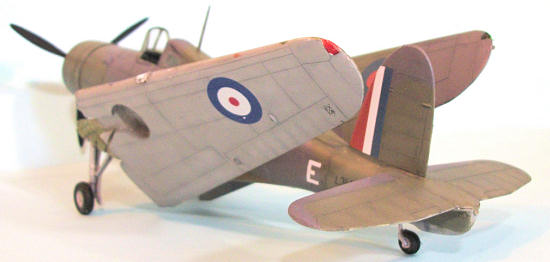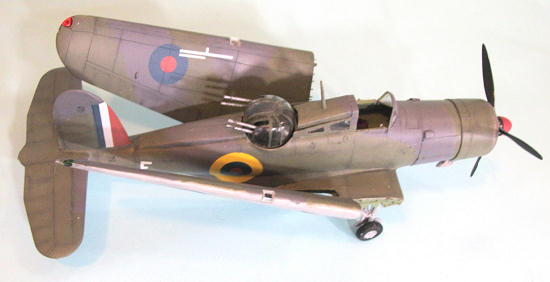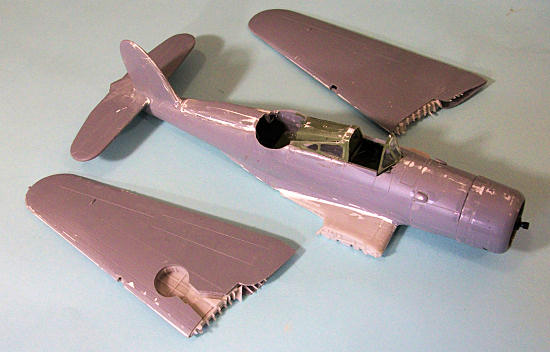Special
Hobby 1/48 Blackburn Roc
|
KIT #: |
? |
|
PRICE: |
$46.00 SRP
|
|
DECALS: |
Four options |
|
REVIEWER: |
Tom
Cleaver |
|
NOTES: |
Alley Cat
Blackburn
Skua/Roc Wingfold Set Used |

How any military service in the late 1930s could call an airplane capable
of a maximum speed of 223 m.p.h. (and that for only a minute while the engine
was in overboost) a "fighter" strains credibility.
That an organization run by actual veterans of air combat could further
conclude that the armament for this alleged "fighter" should be a rotating gun
turret incapable of firing ahead of the aircraft ‑ thus requiring it to find a
way to pull alongside and exchange broadsides with its foe in the manner of
sailing ships in the time of Nelson ‑ is truly mind‑boggling. The
Blackburn
Roc may not be the all‑time worst airplane used operationally by the Fleet Air
Arm, but it certainly is in the running.
Strangely, the only confirmed "kill" of this slowest of all British
fighters was a Ju‑888A‑1, perhaps the fastest of all German bombers at the time,
and certainly capable of out‑performing the Roc.
The
Blackburn
Roc was developed from the Skua Fighter/Dive Bomber, the first monoplane taken
into service by the Fleet Air Arm in 1938. The Roc was fitted with a turret
mounting four .303 Browning machine‑guns, and its production was the
responsibility of the Boulton‑Paul, the company which designed and manufactured
the turret. Since it was based on
an existing airframe, there was no prototype as such; the first of 136 first
flew on December 23, 1938.
 The primary visual difference between Roc and Skua ‑ other than the
turret ‑ was the fact the Roc's wings had dihedral, thus doing away with the
Skua's upturned wing tips. While the Roc carried no forward‑firing armament, it
could carry a 250‑lb bomb under each wing, and an additional load of light bombs
on a "light series carrier."
The extra weight of the turret made it even slower than the Skua.
One Roc, sent to intercept a Heinkel He‑60 seaplane used in the Channel
for air rescue was incapable of catching even this slow biplane.
The primary visual difference between Roc and Skua ‑ other than the
turret ‑ was the fact the Roc's wings had dihedral, thus doing away with the
Skua's upturned wing tips. While the Roc carried no forward‑firing armament, it
could carry a 250‑lb bomb under each wing, and an additional load of light bombs
on a "light series carrier."
The extra weight of the turret made it even slower than the Skua.
One Roc, sent to intercept a Heinkel He‑60 seaplane used in the Channel
for air rescue was incapable of catching even this slow biplane.
While the Roc was designed to use floats earlier used by the Blackburn
Shark, only four Rocs were modified this way and it was found the flying
qualities of the float‑equipped Roc was poor, even with the later fitting of a
large dorsal fin for added stability. This development was the result of a
suggestion by the Director of Air Material that a Roc floatplane could be used
by the Royal Navy's battleships, with three each for "Malaya," "Warspite,"
"Repulse," "Renown," "Queen
Elizabeth" and "Valiant," and one for "Rodney."
When the Winter War broke out between
Finland
and the
Soviet Union,
the Royal Navy decided to send 33 Rocs to the Finns. Preparations went so far as
painting the aircraft in Finnish camouflage and collecting them in
Scotland
for flight delivery to
Finland,
though the Winter War ended before this could occur. Given the Finnish
reputation for getting the most out of the aircraft they operated, it is
interesting to speculate what thy might have done with the Roc. By all accounts,
the performance of the Roc as a dive bomber was far better than as a fighter; if
it flew its getaway just above the ground or sea, it would have been a difficult
target for enemy fighters, and there would have
been a good chance the turret could chase off an attacking fighter.
 The Roc never equipped a full squadron, but was rather operated with the
Skua fighter/dive bomber. Its first
use operationally was for defense
of
Scapa Flow,
and then in defense of the British Fleet off
Norway.
On
April 23, 1940,
800 and 803 squadrons had 2 and 3 Rocs with them respectively when they sailed
HMS "Ark
Royal," to take part in operations in
Norway.
The three 803 Rocs were launched twice on April 28 to drive off German
aircraft shadowing the task force. A combined flight of Rocs and Skuas from 806
and 801 Squadrons made a very effective dive‑bombing attack in German forces in
Belgium
in late May, which allowed several units of the B.E.F. to make their escape back
onto
Dunkirk.
The Roc never equipped a full squadron, but was rather operated with the
Skua fighter/dive bomber. Its first
use operationally was for defense
of
Scapa Flow,
and then in defense of the British Fleet off
Norway.
On
April 23, 1940,
800 and 803 squadrons had 2 and 3 Rocs with them respectively when they sailed
HMS "Ark
Royal," to take part in operations in
Norway.
The three 803 Rocs were launched twice on April 28 to drive off German
aircraft shadowing the task force. A combined flight of Rocs and Skuas from 806
and 801 Squadrons made a very effective dive‑bombing attack in German forces in
Belgium
in late May, which allowed several units of the B.E.F. to make their escape back
onto
Dunkirk.
The only confirmed kill by a Roc occurred on
May 29, 1940,
when 806 squadron claimed one Ju‑88A shot down and another damaged north
of
Dunkirk
near
Ostend.
On June 21 and 23, 1940, 801 Squadron's Rocs were involved in dive bombing
attacks on Bologne harbor, and in attacks on gun positions on Cap Griz Nez on
June 21st, during which one Roc was shot down. After 1940, Rocs were relegated
to training and target towing duties, with the turret removed. The last Rocs to
go to sea served in 806 Squadron aboard HMS "Illustrious" during her shake‑down
cruise to the
Bahamas,
where they were off‑loaded and left behind. The last operational Rocs were
withdrawn due to lack of spare parts during 1943.
Pavla made a Roc in 1/72 limited-run plastic, and Warrior did a 1/48 Roc
in resin which I reviewed back in 2003 or so.
The Special Hobby 1/48 Roc was released in 2007.
Given the poor reputation for fit of
their Skua, the Roc probably suffered in the
 sales
department, though in fact it doesn't have the problems associated with the Skua
in the wing assembly.
sales
department, though in fact it doesn't have the problems associated with the Skua
in the wing assembly.
Comparing the Special Hobby kit with the Warrior model, the surface
detail of the Warrior kit is superior, and a better-looking model results,
though there is a lot more effort involved with the full-resin kit to get there.
The Warrior kit is no longer in production, and getting one now will be
much pricier than the Special Hobby kit.
About a year ago, Alley Cat Models released a resin wingfold set that
could be used with either the Special Hobby Skua or Roc.
The set includes a resin wing center section, and the interiors of the
outer wings at the fold, along with a set of replacement resin wheel wells.
This interested me enough to pull out the kit, which had been languishing
in a box in the garage for a few years, and do this conversion, since it results
in a very interesting model.
This is a fairly simple conversion, since the main part - the wing center
section - is a drop-fit for the kit part.
Since this part comes for both the Skua and Roc, there is a resin plug
provided to fill in the bomb-carrying area on the underside associated with the
Skua. Fit is such that once it's
glued in, you will need to sand it down quite a bit before adding any putty or
surfacer.
 The resin parts for the outer wing roots fit easily once you sand down
the plastic wing halves so they are a “scale” thickness. You need to test-fit to
get a good fit for the resin parts.
The resin parts for the outer wing roots fit easily once you sand down
the plastic wing halves so they are a “scale” thickness. You need to test-fit to
get a good fit for the resin parts.
The kit itself comes with the fore and aft turret fairings in the raised
position. I cut these out of the
cockpit center section and the rear fuselage, and installed them in the lowered
position.
As noted in the kit review, this is one of Special Hobby's better-fitting
releases. I assembled the cockpit
per the kit instructions and painted it with Tamiya “Japanese Cockpit Green”
which is really Mitsubishi Interior Green and close enough the British Interior
Grey-Green to be an easy replacement.
The turret required quite a bit of filing and fitting to get everything
to look right, not to mention a very tedious masking process for painting.
I had to scrape out and thin the interior of the kit in the turret mount
area to get the turret to sit low enough to look right.
The prop is completely wrong for the Roc, and I sourced a replacement
from an Accurate Miniatures B-25 prop, sanding the blades to the proper shape.
Once the fuselage and wing sub-assemblies were completed, I painted the
model. I decided to do the 759
Squadron airplane that is on the boxart, since my earlier kit had the other,
later Royal Navy camouflage. I used
Xtracrylix Extra Dark Sea Grey and Dark Slate Grey for the upper colors, and
Tamiya Sky Grey for the lower. Since the airplane was painted in camouflage
 after
original delivery in silver lacquer, I did this freehand to get the soft edges
seen in the photos of this particular airplane.
The very thin kit decals went on over a coat of Xtracrylix Gloss varnish
without any problem.
after
original delivery in silver lacquer, I did this freehand to get the soft edges
seen in the photos of this particular airplane.
The very thin kit decals went on over a coat of Xtracrylix Gloss varnish
without any problem.
The photoetch bomb racks looked pretty terrible after I assembled them,
so I did not use any of them.
Photos of this airplane show it being flown without the pilot's canopy, so I did
not use the kit canopy here. I
fitted the wheels and prop and unmasked the canopy, and fitted the turret in
position. I attached the wings to
the fuselage with a piece of wire glued into the inner wing root where it can't
be seen to provide the main strength of the joint, with the wing slid onto it.
Even so, this is a pretty weak joint, and the model should never be
handled anywhere but the forward fuselage once the wings are attached.
The Alley Cat conversion is not difficult for anyone who has done
conversions before, and the result is striking, with the very different wingfold
of the Roc from other carrier aircraft.
This is a project for experienced modelers, and those who like Fleet Air
Arm subjects will enjoy the results.
Tom
CleaverMay 2012
Review Kit courtesy of
Special Hobby for giving them a tour of Planes of Fame at the 2007 IPMS Nats.
Copyright ModelingMadness.com. All rights reserved. No reproduction in any form without express permission from the editor.
If you would like your product reviewed fairly and quickly, please contact
the editor or see other details in the Note to
Contributors.
Back to the Main Page
Back to the Review
Index Page 2025




 sales
department, though in fact it doesn't have the problems associated with the Skua
in the wing assembly.
sales
department, though in fact it doesn't have the problems associated with the Skua
in the wing assembly.
 after
original delivery in silver lacquer, I did this freehand to get the soft edges
seen in the photos of this particular airplane.
The very thin kit decals went on over a coat of Xtracrylix Gloss varnish
without any problem.
after
original delivery in silver lacquer, I did this freehand to get the soft edges
seen in the photos of this particular airplane.
The very thin kit decals went on over a coat of Xtracrylix Gloss varnish
without any problem.